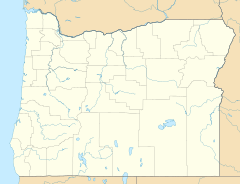Tolo, Oregon facts for kids
Quick facts for kids
Tolo, Oregon
|
|
|---|---|
| Nickname(s):
Construction City
|
|
| Country | United States |
| State | Oregon |
| County | Jackson |
| Established | 1888 |
| Elevation | 1,171 ft (357 m) |
| Time zone | UTC-8 (Pacific (PST)) |
| • Summer (DST) | UTC-7 (PDT) |
| Area code(s) | Area code 541/458 |
Tolo is a small, unincorporated community in Jackson County, Oregon, United States. It's located north of Interstate 5, between the towns of Central Point and Gold Hill.
Tolo was planned in 1888 near an old mining camp called Willow Springs. People hoped it would become one of the biggest cities in Southern Oregon. However, by 1918, Tolo was almost completely empty. In 1986, the land where Tolo was planned became public property again.
Contents
Tolo's Early History
Before settlers arrived in the mid-1800s, several Native American tribes lived in the Rogue River valley. These included the Shasta, Takelma, Latgawa, and Athabaskan peoples.
In the 1820s, early hunters and trappers from the Hudson's Bay Company traveled through the area. Later, in the 1840s, American settlers began passing through on the Applegate Trail. By the early 1850s, many white settlers moved into the Rogue Valley. This led to conflicts with the Native people.
The Table Rock Treaty and Fort Lane
To try and bring peace, the Table Rock Treaty was signed on September 10, 1853. This treaty created the first Native American reservation in the Pacific Northwest. It included areas like Upper and Lower Table Rock and Sams Valley.
The treaty also called for a fort to protect the Native Americans. Fort Lane was built in 1853 in the area that would become Willow Springs, and later Tolo. Soldiers from the U.S. Army were stationed there to keep peace between the settlers and Native peoples.
However, tensions continued to grow, leading to the Rogue River Wars in 1855-1856. After these wars, Native Americans from southwest Oregon were moved to a new reservation. Fort Lane became the Army's base for this relocation.
How Tolo Grew
After the Native Americans were moved, Willow Springs continued to develop. A post office opened there in 1864. Mines, quarries (places where stone is dug up), and mills (factories for processing materials) started operating in the area. In 1871, the land where Fort Lane stood was sold to investors.
In 1886, the name Willow Springs officially changed to Tolo. Many people believe the name was meant to be Yolo, like Yolo County, California. But they think postal workers misread the "Y" as a "T". However, records show that the name "Table Rock" was first chosen but rejected. Then, "Tolo" was clearly written down.
The word "Tolo" comes from the Chinook Jargon, a trade language. It means "windfall" or "payday." This name likely showed the founders' hopes for Tolo to become a big, successful city in Southern Oregon.
In 1888, a lawyer named Paine Page Prim officially planned out the town of Tolo.
Tolo's Decline
Around the early 1900s, Tolo started to shrink. The Tolo post office closed in 1897. However, two brothers, Colonel Frank H. Ray and Doctor Charles R. Ray, from New York, began new projects in Tolo. The post office reopened in 1898.
The Ray brothers opened a rock quarry, which gave Tolo its nickname, "Construction City." From 1902 to 1904, they built the Gold Ray Dam. This was the first hydro-electric plant in Southern Oregon, bringing electricity to the region.
By 1915, it was clear that Tolo would not become the large city its founders had dreamed of. Its population stayed around 150 people. Even though it had a brick plant, quarry, sawmill, and gold mines, it didn't grow much. In 1918, the post office and the train station closed for good.
In 1986, the Jackson County Commission returned the land, which included 474 building lots and public streets, to public ownership.
Tolo's Future
The Jackson County Commissioners have marked the Tolo area for future industrial development. This means it could become a place for factories and businesses, similar to the Medford Industrial Park in White City.



